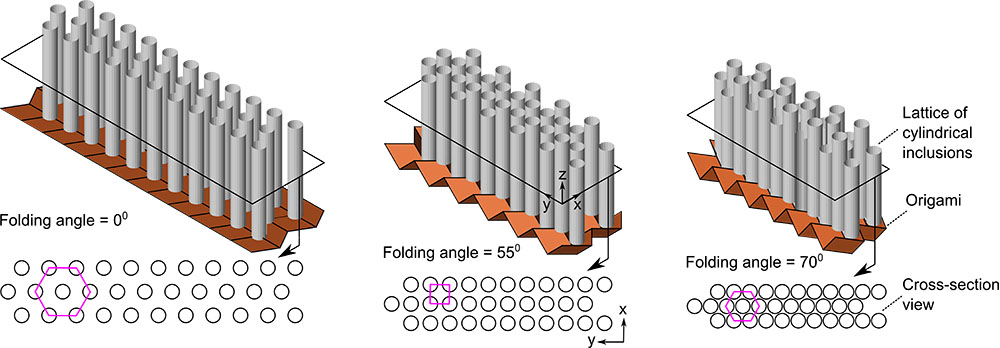
Managing traffic noise pollution has vexed researchers because of the broad range of frequencies we encounter on the road. Currently, only heavy, wall-like barriers can dampen all of these various sounds.
A pair of researchers at the University of Michigan in Ann Arbor have brought a new method into the fold, developing an origami lattice to reduce acoustic noise in roadways. The technique allows researchers to selectively dampen noise at various frequencies by adjusting the distance between noise diffusing elements. They report their work this week in the Journal of Applied Physics, from AIP Publishing.
“Our main contribution is we’re developing an adaptive structure that can change its periodicity between different Bravais lattices with distinct symmetry properties,” said Professor Kon-Well Wang, one of the study’s authors. “It is known that if you reconfigure the lattice structure in such a manner, you will change the wave propagation characteristics significantly.”
“In the origami sonic barriers, noise diffusing cylinders called inclusions are placed on an aluminum sheet bent into a Miura fold. The resulting lattice contains only one degree of freedom, making it particularly easy to collapse and expand,” said Manoj Thota, another author of the paper. “As the lattice collapses or expands, the inclusions are drawn closer together or further apart, diffusing noise in different frequency ranges.”
Heavier vehicles produce noise at lower frequencies than lighter vehicles. Cars traveling quickly during off-peak times skew toward higher frequencies than cars stuck in traffic jams.
Traditional concrete walls that line the roadway are effective across a broad spectrum of noise frequencies, but the wind they block can add significant unwanted force on their foundations. Traditional treatments also have other disadvantages.
When a sound wave is impinged on these kinds of walls, they are reflected back into the road side, said Thota. Being flat, the reflected wave is not diffusive enough to reduce the amount of sound on the road. Further, with straight top edge, the incidence of oblique waves onto these barriers leads to higher diffraction and increases the sound propagation across the barrier.
The researchers’ work draws on periodic sounds barriers, in which a series of inclusions dampen sound at certain frequencies while allowing wind to pass through. The drawback, Thota said, is that these systems are fixed designs. If a system is designed to alleviate noise from traffic jams, it’s not as useful when cars are moving fast.
As more drivers take to the road, Thota said, there has been growing concern about the impact noise has on blood pressure, hearing loss and attentiveness at work and school. In a prototype, Thota and Wang found their barrier reduced acoustic pressure by 10db, or 90 percent.
“The traffic noise that could otherwise be heard as far as a mile away would now only be perceived from a distance of 0.3 miles with these barriers,” Thota said. “That is comparable to the insertion loss in barriers used today, except this can be adapted for certain frequencies. Further, this kind of structure has corrugated façade and top edge, which will have better sound diffusion properties than traditional barriers.”
Benefits of origami structures might extend out of traffic noise reduction, Wang said, citing its potential in achieving other adaptive functions in wave guiding and acoustic diodes.
“Overall, origami structure gives us an effective platform to adapt to environmental change,” he said.
Since published in the Journal of Applied Physics, their work has attracted media attention worldwide:
- “Origami Lattice Paves the Way for New Noise-Dampening Barriers on the Road,” Physics.Org.
- “Origami Gegen Verkehrslärm,” Weltder Physik.
- “Roadside Barrier That Folds Like Origami Blocks Traffic Noise,” New Scientist.
- “A New Wrinkle in Dampening Traffic Noise,” Engineering360.
- “Reticoli Di Origami Come Barriere Antirumore In Strada,” Notizie scientifiche.it.
- “Sonic Barrier Quietens Traffic Noise with Origami,” PhysicsWorld.
